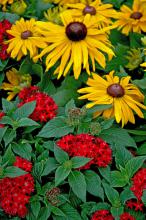Information Possibly Outdated
The information presented on this page was originally released on June 1, 2006. It may not be outdated, but please search our site for more current information. If you plan to quote or reference this information in a publication, please check with the Extension specialist or author before proceeding.
Pentas shine brightly in the heat, humidity
By Norman Winter
MSU Horticulturist
Central Mississippi Research & Extension Center
These first hot summer months send people searching for some colorful flowers that can take the Mississippi heat and humidity while providing a dazzling display in the landscape. With those goals in mind, pentas are hard to beat.
Pentas, also called Egyptian star cluster, originated in tropical Arabia and East Africa. They are related to Ixora and our beloved gardenia. The leaves are shiny and attractive, making for a great contrast with the colorful, star-shaped blossoms. In fact, the name pentas comes from the Latin word for five because of the five floral petals.
Like many other flowers I write about, the pentas has been going through a revival of sorts with new varieties coming on the market at a very brisk pace. Among the new varieties gaining a lot of notice is the Graffiti series.
The Graffiti series is like our Mississippi Medallion award-winning Butterfly series in that it is an F1 hybrid. The Butterfly series reaches 20 to 24 inches tall, but the Graffiti series is more compact, reaching 12 to 15 inches.
The Graffiti series is making its debut this year so local garden centers may not have them. Don't fret because they mostly likely will have other great varieties. One of the selections in the new series is called Graffiti Red Lace. A couple of month ago I got a promotional piece on it and could not believe the photo. The flower was so incredibly beautiful I thought it was surely computer enhanced.
I recently had the opportunity to see them with my own eyes, and I believe it is the prettiest of the pentas on the market. The Graffiti Red Lace produces deep red flowers positioned well above the foliage. The lace description comes from tiny white filaments protruding from each individual red floret.
Blooms will be produced in abundance all summer long if beds are prepared correctly. Choose a site in full sun for best flower production. Prepare the bed by incorporating 3 to 4 inches of organic matter, and till to a depth of 8 to 10 inches. While tilling, incorporate 2 pounds of a slow-release, 12-6-6 fertilizer.
The next step may be the most crucial to happiness with pentas. If the soil is acidic and you grow azaleas, camellias or blueberries with ease, add lime to the pentas' planting area. While preparing the soil, add 5 pounds of a pelletized lime per 100 square feet in sandy soil, or 10 pounds in a clay-based soil. This is recommended because pentas prefer a soil pH of 7.
Many gardeners annually apply lime to grass or vegetable gardens, and in this case, a little will help the pentas keep their flowers all summer.
Pentas are loved by both butterflies and hummingbirds and fit any style of garden. I like them in a tropical setting in front of bananas and elephant ears. In traditional gardens, place them in a bed in front of evergreen shrubs like hollies, ligustrums, wax myrtles or junipers. By the way, they're also great in the vase as cut flowers.
In many gardens, pansies have reached the point where they need to be removed. Do it, and plant tough flowers like pentas. When the Graffiti series becomes available, you'll want to give them a try.



